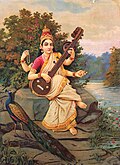The following is a list of composers of Carnatic and Hindustani music, subgenres of Indian classical music, who have created ragas.
| Composer | Genre | Raga Created | Remarks | Ref |
|---|---|---|---|---|
| Goddess Parvati | Malkauns | Its believed that this raga was created by goddess Parvati to calm lord Shiva | [1] | |
| Lord Shiva | Deepak | This raga believed to be created by Lord Shiva and there is a myth that singing it creates fire. Tansen sang this raga in court of Akbar | [2] | |
| Swami Haridas | Hindustani music | Brindavani Sarang | It is believed Swami Haridas brought Lord Krishna to earth by singing this raga who took the form of an idol which can still be seen in Mathura | [3] |
| Tana Riri | Hindustani music | Malhar | Twin sisters became renowned as the only singers who were able to cure Tansen in whole India by singing Raag Malhar | [4] |
| Tansen | Hindustani music | Megh Malhar | [2] | |
| Miyan ki Malhar | Tansen created this raga to bring rain | [2] | ||
| Gaud Malhar | [2] | |||
| Bilas Khan | Hindustani music | Bilaskhani Todi | [5] | |
| M. Balamuralikrishna | Carnatic music | Mahati | Balamuralikrishna created this raga in four notes | [6] [7] |
| Lavangi | Balamuralikrishna created this raga in four notes | [8] [9] | ||
| Ganapati | Balamuralikrishna created this raga using three notes | [10] | ||
| Tyagaraja | Carnatic music | Vivardhani | Saint Tyagaraja invented two ragas both ragas with four swaras in the arohana and have six swaras in the avarohana | [11] |
| Navarasa Kanada | ||||
| Mahesh Mahadev | Carnatic music & Hindustani music | Sri Tyagaraja | Mahesh Mahadev created this raga and named after saint 'Tyagaraja' | [12] [13] |
| Hindustani music | Amritha Kalyani | [14] [15] | ||
| Nada Kalyani | [14] | |||
| Mukthipradayini | [14] [15] | |||
| Carnatic music & Hindustani music | Rajasadhaka | Raga named after Indian scientist Y. S. Rajan | [14] | |
| Binduroopini | [16] | |||
| Carnatic music | Sri Jnanakshija | Mahesh Mahadev created "Sri Jnanakshija" raga which is named after goddess Jnanakshi Rajarajeshwari, Janya raga of the 21st Melakarta raga Keeravani. | [17] [18] | |
| Carnatic music & Hindustani music | Samya | Mahesh Mahadev created this Raga on Chaitra Purnima day, named after Lord Chitragupta, Samya is a raga attributed to justice and fairness, ensuring impartial judgment of individual deeds. | [19] | |
| Mayurapriya | [16] | |||
| Thyagaraja Mangalam | Mahesh Mahadev created this raga and named after carnatic musician T. M. Thyagarajan | [20] | ||
| Tapaswi | [16] | |||
| Ekamukha | [16] | |||
| Srirangapriya | Mahesh Mahadev created this raga and composed kirtana with Graha bedam with Ahir Bhairav raga written by Yogi Nareyana sung by S. P. Balasubrahmanym | [14] [20] [21] | ||
| Srijanani | [22] | |||
| Hameer Tarang | [16] | |||
| Shivakanthi | [16] | |||
| Ekamukha | [16] | |||
| Rudraranjani | [16] | |||
| Lalithavarali | [16] | |||
| Mayakara | [16] | |||
| Hindustani music | Bhimsen | Mahesh Mahadev created this raga and named after ‘Bharat Ratna’ Pandit Bhimsen Joshi (BHIM) Miaya Tansen (SEN) | [14] [15] | |
| Carnatic music & Hindustani music | Pranava | [16] | ||
| Naagadhaari | [16] | |||
| Thrinayani | [16] | |||
| Muthuswami Dikshitar | Carnatic music | Amritavarshini | Muthuswami Dikshitar brought rain at Ettayapuram, Tamil Nadu, India by singing his composition in this raga, "Aanandaamrutakarshini amrutavarshini". | [8] [9] |
| Udayaravichandrika | [8] [9] | |||
| Ramaswami Dikshitar | Carnatic music | Hamsadhvani | This raga was created by Ramaswami Dikshitar (1735–1817), father of Muthuswami Dikshitar. | [23] |
| Shyama Shastri | Carnatic music | Chintamani | Shyama Shastri created this raga and composed 'Devi Brova Samayamide' Kriti in Telugu | [24] |
| Lalmani Misra | Hindustani music | Madhu Bhairava | [25] | |
| Jayachaamarajendra Wadiyar | Carnatic music | Jayasamvardini | [26] | |
| Maharaja Swathi Thirunal | Carnatic music | Saranganatta | [27] | |
| Lalita Panchamam | [27] | |||
| Dvijavanti | [27] | |||
| Gopika Vasantam | [27] | |||
| Mohana Kalyani | [27] [28] | |||
| Ravi Shankar | Hindustani music | Shyam Bihag | [29] | |
| Baleshwari | [29] | |||
| Jog Todi | [29] | |||
| Ahir Lalit | [30] [29] | |||
| Rasiya | [30] [29] | |||
| Yaman Manjh | [30] [29] | |||
| Gunji Kanhara | [30] [29] | |||
| Tilak Shyam | [30] [29] | |||
| Rasiya | [31] | |||
| Banjara | [31] | |||
| Suvarna | [31] | |||
| Piloo Banjara | [31] | |||
| Doga Kalyan | [31] | |||
| Nanda Dhwani | [31] | |||
| Natacharuka | Created for his daughter Anoushka | [31] | ||
| Janasanmodini | [30] [29] | |||
| Bairagi | [31] | |||
| Ilayaraja | Carnatic music | Panchamukhi | [32] | |
| Ravana | Khamboji | Created to praise lord shiva | [33] | |
| Mysore Manjunath | Carnatic music | Yaduveer Manohari | Named after Yaduveer Krishnadatta Chamaraja Wadiyar | [34] |
| Sadananda Mukhopadhyaya | Hindustani Music | Daiva Malhar |
